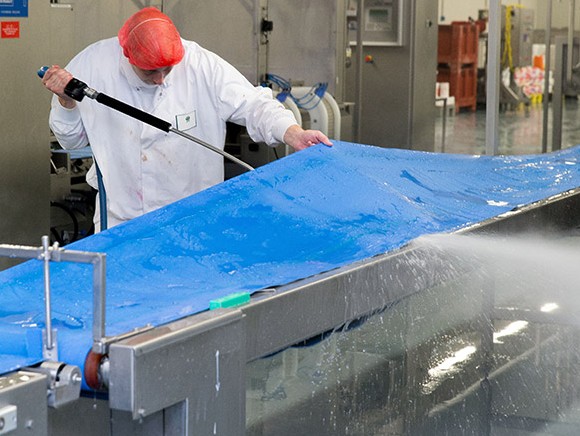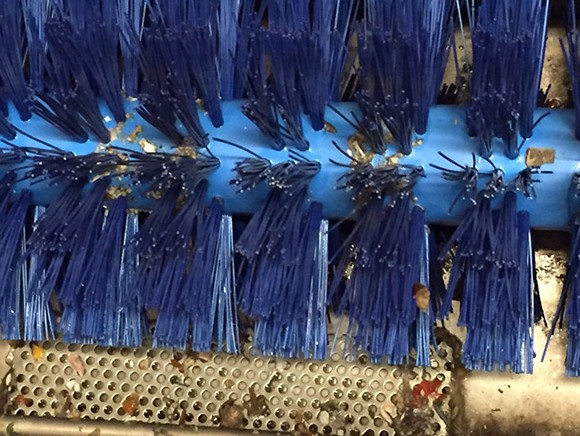
In the food industry there is always a chance of Listeria contamination, claims Gert Visscher from Eco2Clean. “But a consistently disciplined daily production routine, good cleaning and disinfection, post-cleaning visual inspection and continual monitoring can considerably reduce that chance.”
Recalls are regularly triggered by Listeria contamination in food products. Lysteria Monocytogenes is a gram-positive, non-spore-forming bacterium that widely occurs in raw vegetables, unpasturised milk, raw and cooked poultry, on fermented meat products and in raw and cooked fish. Between one and ten percent of all people carry Listeria. “Hence there is an ongoing risk of Listeria contamination from the raw materials and other sources in the production environment,” explains Gert Visscher.
Lysteria Monocytogenes causes the infection listeriosis which can be fatal, particularly for pregnant women and people with a weak immune system although healthy people can also die of it. Unlike other sources of infection, these bacteria thrive at low temperatures which is one thing that makes it easy for Listeria bacteria to gain a foothold in food production environments. The bacteria are often found on difficult-to-clean surfaces. According to Gert, two sources of contamination are seriously underestimated: “One is insufficiently consistent cleaning quality, and the other is a lack of discipline among production workers and maintenance staff. Old dirt poses a very high risk - think of remnants of food products left behind in machinery or on the floor due to below-average or poor cleaning in combination with sub-optimally designed equipment and apparatus.”
Risks of a Listeria contamination can be found everywhere. “Sections of floor that remain damp for a long time are a paradise for Listeria,” states Gert. “Machine components are generally cleaned on the floor, which causes recontamination. Other causes of recontamination are areas of dirt that remain on the floor during cleaning and then splash up from the floor during the rinsing process.”
Cross-contamination is caused by transport equipment (especially wheels on trolleys and forklift trucks) that are used in multiple production areas or driven by people from different production areas. Furthermore, the use of production equipment that has been kept in storage for a while can pose a risk if it is not thoroughly disinfected first. “People often underestimate the consequences of a lack of discipline in the maintenance department,” cautions Gert. “Contaminated or unclean tools, the removal of components that are normally virtually inaccessible, and human contact with system components - these are all very common sources of contamination.”
'Old dirt poses a very high risk'
To prevent Listeria contamination, Eco2Clean works closely with each customer and cleaning team to draw up a management plan. The plan comprises the establishment of a customer-specific monitoring programme, the provision of targeted training to cleaning employees and the management of the cleaning activities. “We do this using the software tool HIMS that we developed in-house,” says Gert. “This integral approach enables us to pick up the presence of Listeria at an early stage, so that widespread Listeria contamination and a potential recall can be avoided.” Before production starts, and periodically also at the weekend or during other moments of downtime, all apparatus should be thoroughly inspected to check that it is visually clean. Any deviations should be recorded in such a way as to facilitate structured analysis of those weak points. "In addition to identifying high-risk areas, companies should also initiate weekly (as opposed to monthly) bacteriological checks. Supplement this with an intensive hygiene inspection every 3 to 6 months."
Ideally, companies should not test for Listeria themselves; it is better to let a specialised laboratory conduct the analysis, according to Gert. “Listeria contamination is difficult to ascertain. In the case of infection, sub-samples must be analysed separately from aggregate samples. Furthermore, analysis of finished products is complex because, rather than being spread evenly throughout a whole batch, contamination levels are often high in small parts of the batch. Once Listeria contamination has been confirmed, it really is important to conduct weekly microbiological checks.”
Disinfectants based on peracetic acid or other peroxy acids are effective in combating Listeria. Eco2Clean has a number of approved agents for this, such as FoodClean DES 40 for closed systems and water systems, and FoodClean DES 41 for equipment surfaces and walls/floors. In addition, the company has a new range of approved non-rinse disinfectants based on organic acids and peroxides.

Listeria contamination carries a considerable risk of the formation of biofilms. If Pseudomonas (common in drinking water), for example, remain behind due to poor-quality cleaning, they can form a biofilm which can also harbour Listeria. Traditional cleaning agents and disinfectants are often unable to destroy the structure of - and hence eliminate - a biofilm. Eco2Clean has enzymatic cleaning agents that treat and definitively remove biofilms¬. To prevent formation of a new biofilm, the daily cleaning routine must be adapted slightly and the biofilm cleaning must be repeated periodically.
Source: © Eco2Clean